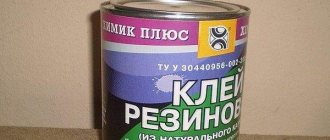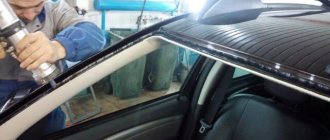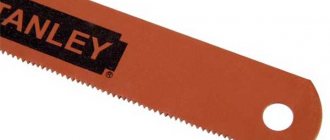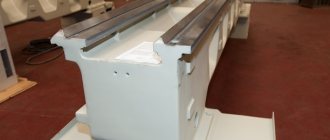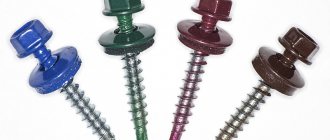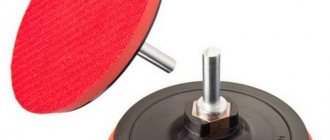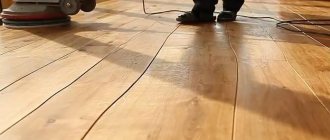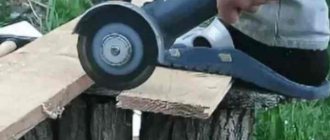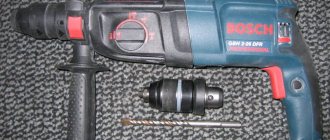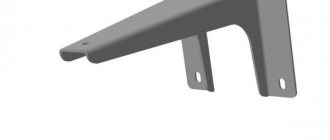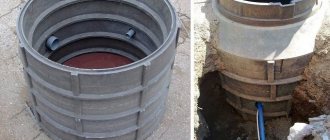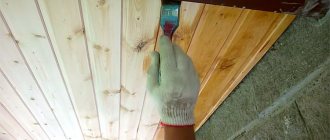A two-component adhesive composition will help restore the integrity of a wooden structure or “tightly” glue furniture that includes metal parts. Few people know that with the help of “cold welding” Poxipol 14 or 70 ml you can not only repair products made of stone, glass, rubber, rubber and other materials. Poxypol is excellent for working with wood. The main advantages of the glue are ease of use, non-toxicity and the creation of a strong connecting seam between parts made of two different materials.
Rain and wind won't matter!
As a rule, metal rusting and wood rotting occur unnoticed. Both processes proceed slowly and make themselves felt only when the roof over the porch threatens to fall on the owners’ heads. Moreover, rotten wood and rusted metal parts over time can become a threat to the stability of the entire building.
Any anti-corrosion protection is designed to protect the metal from exposure to moisture and oxygen. As a rule, this can be achieved by applying special coatings to steel parts. Some of them, such as chromium, enter into a chemical reaction with steel, others form a film on the surface of the metal, including a special powder.
EVERYTHING YOU NEED FOR THIS ARTICLE IS HERE >>>
When working with wood, in addition to weatherproofing, the best remedy for rot is structural protection. It basically eliminates the contact of the tree with rainwater and moisture from the soil.
Features of wood
The more unreliable link in this duet is the tree. Some of its features (in relation to connections with metal) need to be given attention.
- Since wood can expand with temperature changes and changes in humidity, it is necessary to provide a gap between the elements being connected. This will avoid problems in the future.
- Pre-treatment of material that can become a victim of various pests, mold, moisture or fire is required. In this case, it is better to use compounds that penetrate deep into the wood structure.
The choice of method for connecting dissimilar elements depends on the characteristics of the future structure, as well as on the location where it will be located. For example, for maximum protection of a street structure, it is recommended to lay roofing felt between wooden and metal parts, or coat the wood with bitumen mastic.
Anti-corrosion coated screws
Screws, as a rule, are galvanized or passivated - the latter have a characteristic yellow or dark blue color.
For dark types of wood, blackened screws can also be used, but their anti-corrosion protection is weaker.
Stainless steel screws are the best choice when constructing structures that will be located outdoors.
Formatted screws
(1) are used primarily for dry finishing of premises.
If you use galvanized screws
(2) when working with drywall, then over time they will attract moisture and become visible through the paint layer.
But this will not happen with black, phosphated screws
.
Chrome-plated/passivated screws
(3) can be identified by their yellowish color.
They offer some protection against corrosion, but should not be exposed to constant rain. Stainless steel screws and bolts
(4) are twice as expensive, but are guaranteed not to corrode.
How to glue metal to wood using glue
During World War II, the first results in gluing metal to wood were obtained, and the British produced the first aircraft that used wooden structures bonded to metal using rubber glue.
You can also glue wood and metal with a silicone rod, which is sold at any hardware store. You should buy a rod, heat it with a lighter, lubricate the surface of the metal and glue it to the wood.
Another popular method is gluing wood and metal using epoxy resin. For example, two-component epoxy resin Permabond ET515 or POXIPOL, more popularly known as “cold welding,” is suitable. Another option is the two-component Supergrip adhesive. Any large hardware store has a wide range of adhesives that will help solve the problem of gluing metal and wood.
Corners and other fasteners
The phrase “high-quality steel” does not say anything about the resistance of steel angles or other fasteners to corrosion. Only through special processing or the addition of other metals does steel become corrosion-resistant. The four most common methods for protecting steel from rust and weathering are briefly described below.
The degree of anti-corrosion protection that each of these methods provides is different, which also affects the price of products processed by one or another method. High-quality stainless steel fasteners are the most expensive, but they certainly won’t have any problems with corrosion.
The most budget option is parts made of galvanized steel. But if you want to prevent these parts from rusting, make sure that their coating remains intact. The same applies to powder coated products. Chrome plating is somewhat more resistant to corrosion, but its yellowish color does not always suit the design.
Metal dowels
Durable reinforcement is used to make metal dowels. They are intended to ensure good fastening of the crowns of a log house made of timber or logs to each other. They are durable and can prevent deformation of the wooden material. But it is still not recommended to use metal dowels in the construction of a wooden house. Metal dowels have a corrugated surface, which can lead to damage to the structure of the wooden material during its movement. Metal and wood are not compatible, they are completely different. The metal dowel, being inside the beam, will soon undergo corrosion due to temperature changes, humidity and condensation formed on it. Dowel rust can cause premature deterioration of the wood material.
Weatherproof steel
1. Chrome plated
When chrome plating, pre-galvanized steel parts are dipped in chromic acid, as a result of which a chrome film is formed on the products. It gives very good protection against corrosion to screws and other fasteners, which lasts, as after galvanizing, for approximately 40 years. Just like bronze fasteners, chrome-plated products in color match well with wood used outdoors.
2. Galvanized
When galvanizing, steel acquires a protective layer of zinc. During hot-dip galvanizing, parts are immersed in a bath of zinc heated to +450°C. When galvanizing, zinc is applied to the part.
in an electrolyte bath. Fasteners treated in this way retain their anti-corrosion properties for up to 40 years. True, salty air reduces this period to 25 years.
3. Stainless steel
High-quality stainless steel refers to types of steel that, due to the addition of chromium, nickel, molybdenum or titanium, become completely resistant to corrosion under normal atmospheric influences. At the same time, products with smooth surfaces are even more corrosion-resistant than rough ones, which is why some manufacturers subject their fasteners to special grinding. However, it is wrong to assume that products
made of stainless steel are not subject to corrosion at all. Even this type of high-alloy steel is susceptible to two types of corrosion: crevice and pitting. To maintain a decent appearance of stainless steel, regular washing of metal products with warm water and a surfactant is required.
4. Powder coated
Before applying the powder-varnish coating, the products are galvanized. The powder, then applied to the product, is melted in an oven at temperatures above +200°C. After cooling, a durable anti-corrosion coating is formed on the product. In order for the metal to retain its anti-corrosion properties for a long time, the coating must not be damaged.
Link by topic: How to make a stool-bedside table with your own hands
Advantages of polyurethane adhesives for aluminum
The adhesive compositions based on polyurethane presented in the assortment of modern manufacturers have the following important qualities:
- High strength;
- Wide temperature range of joint operation (from +30 to -80° C);
- Resistance to corrosion of any type;
- Fast hardening;
- Long service life;
- Resistance to static and dynamic loads.
Using polyurethane-based adhesives, aluminum can be combined not only with the same aluminum, but also with other materials. Products on the market are excellent at bonding this metal to steel, polymer materials, and even glass and stone.
It is widely believed that it is impossible to securely connect two aluminum parts without welding or fasteners. This is not so - the use of polyurethane compounds in aviation and shipbuilding suggests that with the help of modern products it is possible to create reliable and durable joints in highly critical products.
This way the supports will last a long time!
Drive-in bases: they do not require concrete
When erecting wooden structures that will have to be located in the open air, it is very important that the wood does not have direct contact with the ground and therefore does not absorb moisture. Hot-dip galvanized pier bases are the easiest and most inexpensive way to install piers stably and keep them dry. On such supports you can install a lightweight structure made of wood or using frame technology.
When hammering the bases into the ground, special tools should be used: a plastic mallet and a plastic plug inserted inside the cartridge - this is where the blows should be struck. If you hit the metal directly with an ordinary hammer, you can damage the upper part of the product.
For optimal protection against moisture, the lower end of the support should be treated with a protective glaze. The holes drilled for fastening must also be impregnated with an antiseptic. The protective coating must be completely dry before installation can begin.
H-shaped anchor
Here are two types of anchors for wood poles installed on a concrete foundation and protected from moisture. The H-shaped anchor is suitable for supports of various sizes. The lower third of the anchor is filled with concrete. Those who find anchoring with a classic U-shaped anchor too noticeable can install the supports with virtually invisible anchors with a support shoe. A notch is made in the middle of the support, holes for fastening bolts are marked in the support, the support is put on the central panel of the anchor and secured with bolts. Then the support is concreted.
U-shaped anchor
Supports buried in the ground sooner or later rot. Before the support collapses, its rotten part should be replaced. To do this, the support needs to be lightly dug up, cut down, and the lower part removed from the ground. The resulting gap between the support and the ground can be filled by installing a metal anchor on a concrete foundation. The lower part of the support should be replaced with a block of suitable size, securing it on both sides with two bars. A concreted wide H-shaped anchor will provide the support with the necessary stability; it is designed for a rack with a thickness of 70-140 mm.
PROTECTION FOR SUPPORTS AND TERRACES
Caps
To prevent rainwater from damaging the tree, special caps are placed on top of the support, the top is filed at an angle or rounded.
This will make your floors last longer.
Structural protection of wood is especially important when installing floors on outdoor terraces.
It will help extend the life of the floorboards. Firstly, the floor of the terrace must be arranged so that it has a slight slope in one direction - this way the water will drain from the terrace by itself.
We illustrated two other simple but effective techniques with drawings.
Correct: the head of the screw remained on the surface of the board. Stainless steel self-tapping screws can break when screwed into hard wood, so you should always pre-drill holes with a slightly smaller diameter than the diameter of the self-tapping screw.
Bad: the head of the screw protrudes above the board or is dented. In the first case, you can get injured by catching on a self-tapping screw. In the second, a depression forms around the self-tapping screw and water collects.
A simple pommel made of galvanized steel can be bought for 140 rubles. in a construction supermarket.
The pommel, made of high-quality steel and decorated with a ball, costs almost 400 rubles.
Plastic tops are intended for children's furniture or playground structures. They protect the tree from rotting and children from injury. Price: 80 rub.
The upper part of the support without a top needs to be either rounded or cut at an angle so that rainwater drains quickly. In this case, the tree must be covered with a moisture-proof solution.
You can purchase a pole top made of wood.
How to attach timber for laying floorboards to a metal profile pipe?
Good afternoon. I need to lay the floor in a hallway with an area of 1.6 x 2.6 meters, the door of which leads to the street. Along the long walls of this room, at a distance of 1.11 meters from each other, there are two channels. I plan to weld a rectangular cross-section profile pipe onto them, and attach beams to it for laying the floorboard. Tell me the best option for attaching the beam to a metal profile pipe.
Combined load-bearing structures, combining metal and wood in different versions, have recently been widely used in the construction of frame houses, fences and gates, installation of roof truss systems, expansion and insulation of balconies and loggias. Depending on the expected load on the structure, choose one of two methods of attaching wood to metal
- on reinforced perforated corners welded to metal;
- joining two materials with special self-tapping screws.
Reinforced perforated connecting corners are usually used when installing rafter structures to enhance the rigidity of the roof, when instead of wooden beams over 10 m long, powerful channels are installed as rafters, ridge supports and purlins.
For lighter load-bearing structures, which include the floor system you are planning in the hallway, the best option for attaching a wooden beam to a metal profile is self-tapping screws of the appropriate length. In this case, the wall thickness of the profile pipe must be at least 2 mm so that the applied thread does not become loose over time.
In practice, any supporting structure where wood and metal work together has a significant drawback - the hygroscopic wood is susceptible to rotting and the metal’s tendency to corrode when in contact with moisture. Therefore, to fasten these two materials, be sure to use special galvanized roofing screws rather than black ones.
Before installation, be sure to treat all wooden elements with antiseptic and moisture-repellent compounds, and it is advisable to paint metal surfaces.
Source
Advantages of polyurethane adhesives for aluminum
The adhesive compositions based on polyurethane presented in the assortment of modern manufacturers have the following important qualities:
- High strength;
- Wide temperature range of joint operation (from +30 to -80° C);
- Resistance to corrosion of any type;
- Fast hardening;
- Long service life;
- Resistance to static and dynamic loads.
Using polyurethane-based adhesives, aluminum can be combined not only with the same aluminum, but also with other materials. Products on the market are excellent at bonding this metal to steel, polymer materials, and even glass and stone.
It is widely believed that it is impossible to securely connect two aluminum parts without welding or fasteners. This is not so - the use of polyurethane compounds in aviation and shipbuilding suggests that with the help of modern products it is possible to create reliable and durable joints in highly critical products.
